What is a balanced scorecard?
The balanced scorecard approach is a strategic performance management system which helps organisations to identify the right KPIs to track, assess and improve their business performance in a holistic manner, taking into account not just financial performance but also a range of other factors that are important to the organisation's success.
A quick summary: The three types of balanced scorecard
The approach has been through three distinct stages of evolution. If you just want to know how to build a scorecard, you can skip this section, but if you need to know about balanced scorecards, it's important to know that there are three quite different versions in common use...
First generation: The four balanced scorecard perspectives
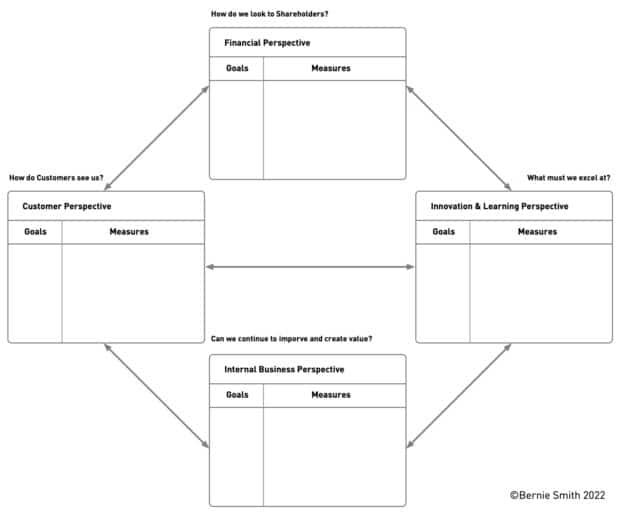
In it's first pass, the BSC described by Kaplan and Norton in early 1992 had four key perspectives:
- Financial perspective: This perspective looks at the organisation's financial performance, including financial measures such as revenue growth, profit margin, return on investment, and shareholder value.
- Customer perspective: This perspective focuses on the organisation's relationship with its customers, including metrics such as customer satisfaction scores, customer retention rates, and net promoter scores.
- Internal business process perspective: This perspective looks at the organisation's internal processes and operations, focussing on internal business measures such as on-time delivery, quality control, and process efficiency.
- Learning and growth perspective: This perspective focuses on the organisation's ability to learn and grow, including metrics such as employee satisfaction, training and development, and innovation.
The four perspectives were designed to give a more comprehensive view of the organisation's performance and critical business processes, by driving the process of selecting a small number of KPIs to help to drive better decision-making and improve performance. Much of the criticism of the balance scorecard approach comes from first generation scorecards. Let's take a look at those [legitimate] criticisms...
Problems with the first generation BSC
- The four perspectives were not so relevant to public sector or non-profit organisations, or units within complex organisations (which might have specialist purpose or function).
- Because there is large amount of subjective judgement in going straight from just four 'high level' perspectives, straight to KPIs, it proved impossible to justify the final metric selection used on any rational basis and hard for the users to have confidence in the final selection.
- There's very limited scope to look at the interaction between the KPIs identified
In short, don't use the first generation model. Whilst it was an attempt to create KPIs based on a predefined set of 'perspectives', performance measurement base too limited to be of real use. Better methods are available, such as the 3rd generation scorecards described below.
Second generation balanced scorecards: introducing strategic objectives
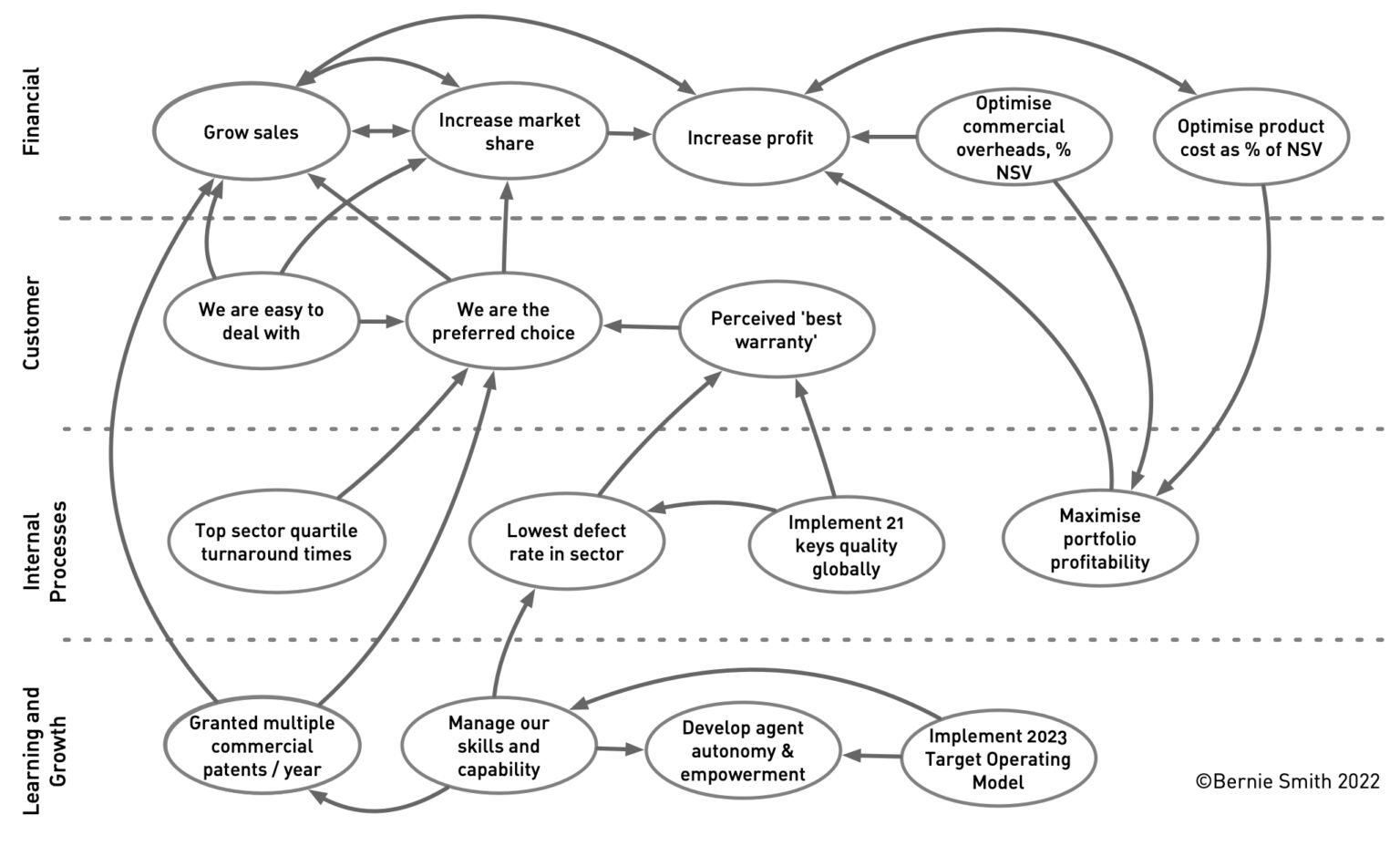
By the mid 90's Kaplan and Norton came up with the idea of the Strategy Map. This added an extra layer, but allocating 'strategic objectives', grouped by the four perspectives. Each strategic objective would then have one or two KPIs attached to it.
Benefits of second generation BSC
They allowed the four perspectives to be broken down into more meaningful goals and outcomes before the relevant metrics are identified, with simple linkage lines up to the top level of the map.
This approach gave far more context and legitimacy to the selected KPIs.
Problems with the second generation BSC
- Whilst there's clearer linkage from KPI to strategy, the 3-level approach (Perspective - Strategy Objective - KPI) can become restrictive and impractical when looking at large and complex organisations.
- The top level perspectives are really categories rather than outcomes or results, so they don't hold much meaning or significance in themselves and will not be comprehensive many types of organisation
Third generation balanced scorecards: linking strategy to measures

Third generation modern balanced scorecards tackle the issue of the 'perspectives' being abstract and not being specific strategic objectives for that organisation and allow us to set different strategic objectives. In third generation scorecards the perspectives are replaced with with strategic results, outcomes or goals. This approach makes the mapping process more flexible and logical. KPI Trees represent a specific type of generation '3+' Strategy Map, with three layers of strategic outcomes (plus KPIs) and relationship mapping (both positive and negative). KPI Trees also allow for the aligned presentation of KPIs and OKRs in a single, logical and visual way.
Benefits of third generation BSC
- The are easier to read, explain and understand.
- When designed correctly, they can represent the most complex of organisations.
- They make no assumptions about the priorities, nature or structure of the organisation being mapped.
- They can show the complex interactions and interdependencies within an organisation.
Problems with the third generation BSC
- Whilst they are easy to read and explain, they are more complex and demanding to create than first or second generation scorecards.
- Starting with a 'blank sheet' for the organisational objectives can be overwhelming.
The implementation advice in this article focuses on generation 3+ (enhanced 3rd generation) scorecards.
How does a balanced scorecard model work?
The underlying principle is quite intuitive. In order to understand how we are performing, we need to measure and target certain elements of our performance. The most important measures (KPIs) will be those that are directly linked to the outcomes we care about (strategic objectives results or outcomes). Our scorecard should be based on those most strategically relevant (and practical) KPIs.
Organisations first need to identify the specific key performance indicators they want to track to deliver the high-level goals, outcomes and results that they have identified in their long-term strategy. A structured and powerful approach is to use KPI Trees and the ROKS framework to identify the best metrics for the organisation.
How To Implement The Balanced Scorecard Framework (With Examples)
The strategic planning and management (SPM) system: The strategic planning and management system is a comprehensive approach to performance management that includes elements of the balanced scorecard, as well as other tools and techniques for strategic planning and decision-making.
The balanced scorecard concept to select your performance measures
When you look for examples of scorecards, you will often see them presented with just outcomes, or results on the diagram. So for example 'We deal well with customers calls' is an outcome...
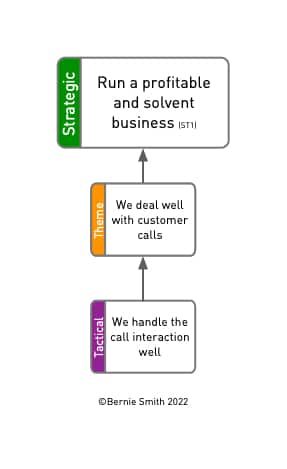
...but 'Post-call feedback score' would be the KPI associated with that outcome.
Although they are very closely related, there may well be several KPIs hanging off each result/outcome and it is not possible to put a number to 'We deal well with customer calls' but it is possible to put a number to 'Post-call feedback score'.
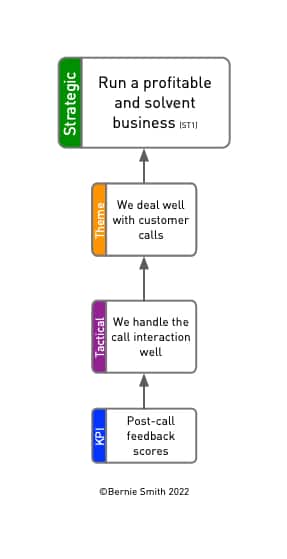
Those using the KPI Tree framework as their third generation scorecard can easily develop their KPIs from the three. Here's an expansion of the example shown above, for a specialised financial services customer services function...

Choosing the right strategic objectives
Key factors to consider when choosing strategic objectives include:
- The organisation's mission and vision: Objectives should align with the organisation's overall mission and vision, and support its long-term goals and objectives.
- The organisation's environment: The strategic objectives should take into account the organisation's external environment, including its competitors, customers, and regulatory and economic factors.
- The needs and priorities of different stakeholders.
- The organisation's resources and capabilities: The strategic objectives should be achievable given the organisation's current resources and capabilities, and should not stretch the organisation beyond its capabilities.
Common advice on strategic objectives is that they should be SMART (specific, measurable, attainable, relevant, and time-bound), with the intention that the objectives are clear and easy to understand, and that progress can be easily tracked and measured. Experience shows that even goals that are SMART can frequently fail, so take a look at the ROKET-DS approach for a more thorough target design process.
Tip: For a simple, practical three step method for goal and objectives statements that actually deliver check out: How to write goal statements
Create your own balanced scorecard
To create your own balanced scorecard, follow these six steps:
- Identify the organisation's strategic objectives and the specific metrics that will be used to measure performance in each of the four areas: financial performance, customer satisfaction, internal processes, and learning and growth. (see the ROKS Enterprise method for a logical, structured way to achieve this)
- Develop targets or benchmarks for each of the metrics, based on the organisation's strategic objectives and past performance.
- Start tracking and measuring performance against the metrics, using data from across the organisation.
- This may involve collecting data from different departments or systems and consolidating it into a single repository.
- Check out this useful implementation page for common implementation issues, solutions and mitigations.
- Identify areas for improvement. This can be done by comparing the organisation's performance against the metrics to the targets or benchmarks that have been set. This should be done in a regular, structured way, typically as an improvement-focused meeting or review.
- Develop and implement solutions to address any areas of weakness or improvement identified in the previous step. Lean Six Sigma methodology has a huge range of relevant tools for process improvement, including...
- Structured problem solving
- Process mapping
- Cycle time reduction (SMED)
- Control charts (for analysing naturally variable processes)
- Continuously monitor and fine-tune the organisation's performance using the scorecard, and make adjustments as needed to ensure that the organisation is meeting its goals or heading towards doing so.
How to use a balanced scorecard
Once those relevant KPIs have been identified, the organisation can start tracking, measuring and adjusting their performance against these metrics. This allows the business to identify areas where there is opportunity for improvement, comparing performance against the targets or goals (key results).
Having identified improvement opportunities the organisation can develop and implement strategies to tackle these problems. This may involve structured problem solving, making changes to processes, implementing new technologies, or providing training and support to employees. It is important that they continuously monitor their performance and make adjustments to keep those improvement activities on-track and focused.
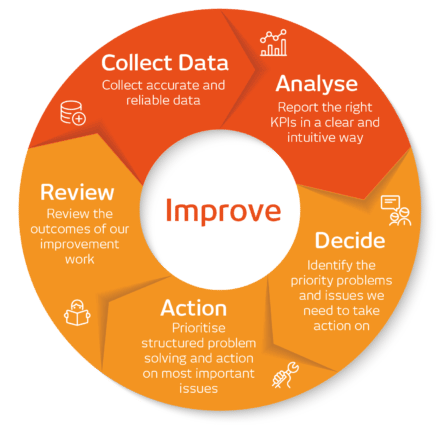
Examples of a balanced scorecard (bsc) for a manufacturing business
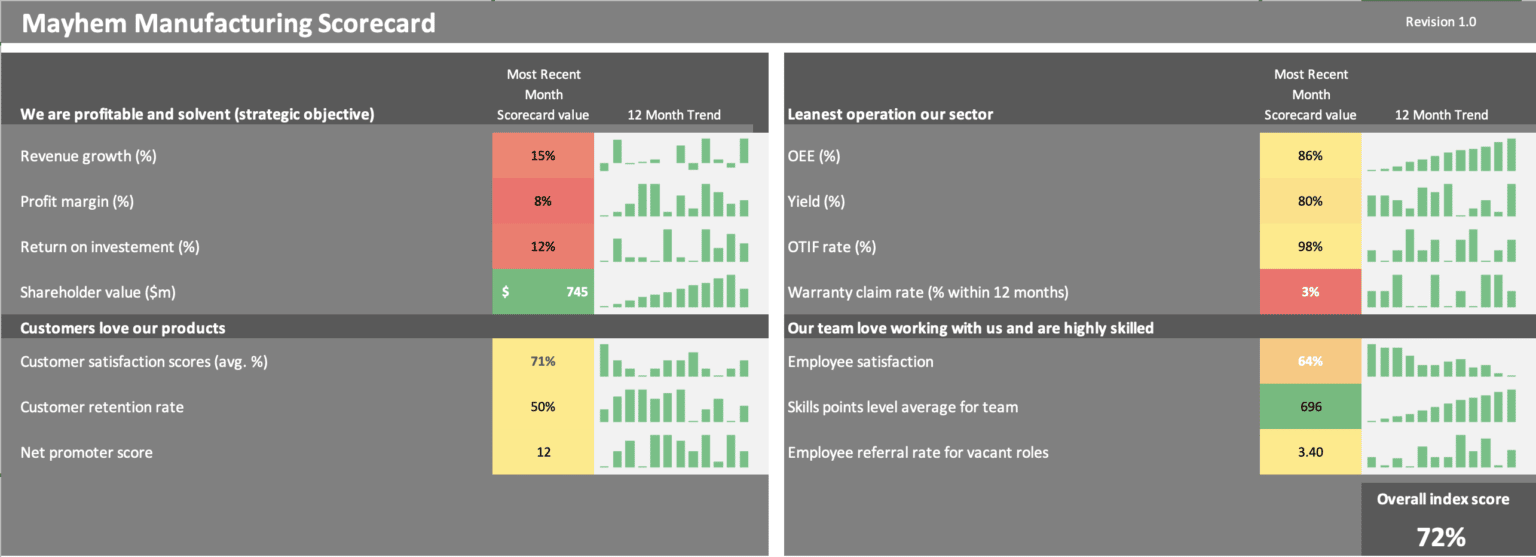
Here are some example metrics from a small, fictional, manufacturing business, Mayhem Manufacturing.
Balanced scorecard measures:
- We are profitable and solvent (strategic objective)
- Revenue growth
- Profit margin
- Return on investment
- Shareholder value.
- Customers love our products (strategic objective)
- Customer satisfaction scores
- Customer retention rates
- Net promoter scores.
- We have the leanest operation in our sector (strategic objective)
- OEE (overall equipment efficiency)
- Yield
- On-time-in full delivery rate (OTIF)
- Gross margin
- Warranty claim rate
- Our team love working with us and are highly skilled (strategic objective)
- Employee satisfaction
- Contribution from new product launches
- Skills points level average for team
- Employee referral rate for vacant roles
Clearly, the specific metrics companies use will depend on the organisation's goals and the needs and priorities of different stakeholders. A retail company might prioritise metrics related to customer satisfaction and sales growth, while a manufacturing company might focus more on metrics related to process efficiency, yield and quality control.
Prebuilt Scorecards
Head to this page for three simple prebuilt scorecards covering production, sales and customer service.
5 Benefits of a balanced scorecard framework
The benefits of using this approach include:
- It allows a more comprehensive view of performance: By looking at performance across a range of different areas, using the four perspectives and covering, for example business processes, an organisation can get a more complete picture of how they are doing and identify areas where they need to improve.
- Alignment with strategic goals: The scorecard helps to ensure that the organisation's activities are aligned with its strategic goals and objectives and enables strategic management. This can help to improve the effectiveness of the organisation's efforts and ensure that they are focused on the most important areas.
- Improved decision-making: By tracking performance against a range of metrics, organisations can make more informed decisions about how to allocate resources and where to focus their efforts to improve.
- Enhanced accountability by providing a clear set of metrics and targets that can be used to evaluate performance.
- Increased engagement and buy-in: By involving different team members in the process of developing and implementing the scorecard approach, organisations can increase engagement and buy-in, and ensure that the metrics and targets reflect the needs and priorities of different groups within the organisation.
5 Common issues with the balanced scorecard framework
Some common issues include:
- Choosing the wrong metrics: Choosing the wrong measures can lead to a distorted view of the organisation's performance and may not provide the insights needed to identify areas for improvement.
- Choosing a too many KPIs: Though a less common issue, it's easy for an organisation to become overwhelmed and gridlocked when a large number of measures are introduced.
- Lack of buy-in from stakeholders: If the organisation's senior executives impose the scorecard on the organisation and the wider management team and workforce is not properly engaged in the initiative, it can be difficult to get them to support and engage with the process.
- Insufficient data or poor data quality: In order for the scorecard to be effective, organisations need to have access to accurate and up-to-date data. If the data is not available or is of poor quality, it may not provide a reliable picture of the organisation's performance.
- Inability to link metrics to strategic goals: If the metrics chosen are not directly linked to the organisation's strategic goals, it can be difficult to see the value and to use it to drive improvement.
- Difficulty in implementing changes: Even if the scorecard identifies areas for improvement, it can be difficult to implement the changes needed to address these issues. This may require a significant investment of time and resources, and may require the support and engagement of different participants within the organisation.
Balanced Scorecard FAQ
Can they be used together, or is it a case of balanced scorecard vs OKR? OKRs (Objectives and Key Results) and the balanced scorecard are both frameworks for tracking and assessing organisational performance. However, there are some key differences between the two approaches:
- Scope: The scorecard looks at performance across multiple areas, including financial performance, customer satisfaction, internal processes, and learning and growth. In contrast, OKRs are focused on a smaller number of specific objectives and the key results that need to be achieved in order to meet those objectives.
- Level of detail: The scorecard typically includes a larger number of metrics and provides a more detailed view of performance. In contrast, OKRs are focused on a smaller number of high-level objectives and key results, and do not provide as much detail about performance.
- Flexibility: OKRs are designed to be flexible and adaptable, and can be easily changed or adjusted as needed to reflect changes in the organisation's goals or environment. In contrast, the balanced scorecard is more structured and may be more difficult to modify or adapt.
- Alignment with strategic goals: Both the balanced scorecard and OKRs are designed to align with an organisation's strategic goals. However, the BSC approach may be better suited for organisations that have more complex or multi-faceted strategic goals, while OKRs may be more appropriate for organisations with more straightforward or focused goals.
Ultimately, the choice between the two approaches will depend on the specific needs and goals of the organisation. Some organisations may find that the BSC provides a more comprehensive view of performance, while others may prefer the flexibility and simplicity of the OKR approach. Looking for an OKR framework, OKR tracking template or OKR template?
Head to this page for more information on OKRs, a useful OKR template and OKR tracking templates.
Note, it is possible to combine the approaches using an 'OKR scorecard template'. Here is an example of a modified KPI Tree (KPI OKR Tree) that shows the principle of the approach...
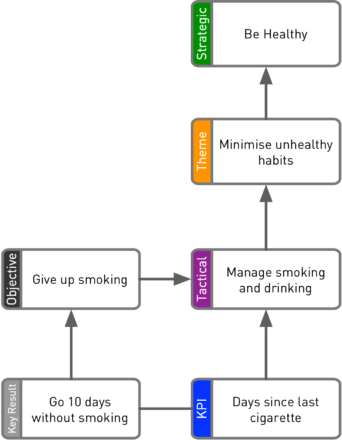
Yes, it is possible to use both the BSC and OKRs (Objectives and Key Results) together. In fact, some organisations may find that combining the two approaches can provide a more comprehensive and effective way to track and assess their performance.
One way to use both approaches together is to use the BSC to track performance across a range of different areas, including financial performance, customer satisfaction, internal processes, and learning and growth. This can provide a broad view of the organisation's performance and identify areas where improvement is needed.
The OKR approach can then be used to focus on specific objectives and key result (or results) within these areas. For example, if the balanced scorecard identifies that customer satisfaction is a weakness, the organisation could use OKRs to set specific objectives and key results related to improving customer satisfaction. This can help to ensure that the organisation's efforts are focused on the most important areas, and can provide a more detailed view of progress towards achieving specific goals.
By using the balanced scorecard and OKRs together, organisations can get a more comprehensive and detailed view of their performance, and can use this information to drive improvement and achieve their strategic goals.
The balanced scorecard is a strategic tool for management developed by two American management consultants, Dr. Robert Kaplan and Dr. David Norton. The concept was introduced in their 1992 article "The Balanced Scorecard - Measures that Drive Performance", in the Harvard Business Review (HBR) and later expanded upon in their 1996 book "The Balanced Scorecard: Translating Strategy into Action".
Prior to the development of the balanced scorecard, performance management systems for so-called industrial age companies were typically focused on financial metrics, such as revenue and profit. Kaplan and Norton argued that this approach was inadequate for tracking the performance of modern organisations, which are often more complex and multi-dimensional. The method was developed as a way to provide a more comprehensive view of performance, by looking at a range of different metrics in different areas.
The approach has since been adopted by organisations around the world, and has become a widely-used tool for performance management and strategic planning.
A strategy map is a visual representation of an organisation's strategic plan. It is a diagram that shows the key goals and objectives of the organisation, and how they are interconnected. The strategy map typically includes a series of boxes or bubbles that represent the different elements of the strategic plan, connected by arrows or lines that show the relationships between them.
The concept was developed by Dr. Robert Kaplan and Dr. David Norton. In their book "The Strategy-Focused Organization", Kaplan and Norton introduced the idea of using strategy maps to represent the strategic plan of an organisation.
The purpose of a strategy map is to provide a clear and concise overview of the organisation's strategic plan, and to help stakeholders understand how different goals and objectives are related. By visualising the strategic plan in this way, the strategy map can help to clarify the organisation's priorities and focus its efforts on the most important areas.
Strategy maps are commonly used in the balanced scorecard approach to performance management, as they provide a visual representation of the organisation's objectives and the metrics that will be used to track progress towards achieving them. However, they can also be used in other contexts, such as strategic planning and decision-making.
KPI Trees are a special form of Strategy Map, specifically designed to accelerate the process of KPI selection.
For third-generation scorecards (which this post focuses on), the top level, or start point, of the scorecard are the longer term strategic objectives. Additional strategic objectives can be added to the KPI Tree in a modified form called a KPI+OKR Tree.
The 'first generation' balanced scorecard system originally had four balanced scorecard perspectives. This proved to be limiting in many situations (especially in not-for-profits, the voluntary sector and specialised organizations), so third generation scorecards no longer follow this prescriptive approach, starting from the high-level strategic objectives of the organisation instead.
Yes, the balanced scorecard is a management system. The balanced scorecard is a framework that helps organisations to track and assess their performance, and to align their activities with their strategic goals. It provides a comprehensive view of performance across multiple areas of an organisation.
Absolutely not! Even first generation scorecards covered the customer perspective. Later, more sophisticated iterations allow complete flexibility to cover every perspective, both internal and external.
Measurement is a vital element of any performance improvement process (It's the M in DMAIC). The scorecard provides a structured approach to come up with the optimal selection of KPIs. Having said that, there may be low-level process metrics that are identified outside of the scorecard design process - typically for structured problem solving work.
Yes, this free Finance KPI Tree should offer a fantastic head-start in building the financial perspective on your scorecard.
The frequency with which the BSC is set will depend on the specific needs and goals of the organisation. Some organisations may choose to review it on a yearly basis, while others may update it more frequently, such as quarterly or monthly.
The exact frequency will depend on the organisation's specific needs and circumstances and on major 'trigger' events, such as a strategy review or takeover.
The right review frequency should be determined by the considering the following, for each KPI..
- How rapidly does it change?
- How important is it to detect change in that metric?
- How long does it take to make a correction once a problem (or opportunity) is detected?
Yes, the balanced scorecard is a strategic management and strategic planning tool. The balanced scorecard is a framework that helps organisations to identify and track the metrics that are most important to their success, and to align these metrics with their strategic goals. By providing a comprehensive view of performance across multiple areas, the balanced scorecard puts the focus on identifying areas where they are doing well and areas where there is room for improvement.
The balanced scorecard approach is often used in conjunction with other strategic planning tools and techniques, such as SWOT analysis, PESTEL analysis, and scenario planning. These tools can help organisations to identify the key drivers of their success and to develop strategies that will help them to achieve their goals.
Yes, the balanced scorecard is a strategic management system. It is a framework that helps organizations to track and assess their performance, using the scorecard information, and to align their activities with their strategic goals. If you are using 2nd or 3rd generation scorecards, it can cover any strategic objective you care to define.
There are plenty of specialist tools out there for building and managing your scorecard. The truth is that for 95% of people and organisations, Excel or Google Sheets will do just fine and they don't come with a hefty monthly subscription. They are both powerful and allow you to shape the tool to cover your exact needs, perhaps linking your scorecard to your objectives, key result or dashboard. Remember, it's not the tool, but the thought process that will bring benefits from this approach.
For incentive plans to be effective, there need to be clear goals, targets (key results) and KPIs. A scorecard can provide this part of the incentive scheme. The rewards, or punishments, you offer hitting or missing those targets are 'incentives'.

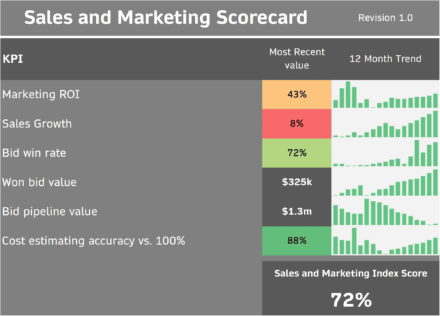



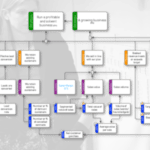
![Complete Guide to the OKR Framework: How to Create OKRs for Your Team [2024] okr kpis and targets logo](https://madetomeasurekpis.com/wp-content/uploads/2021/12/okr-kpis-and-targets-logo@2x-150x150.png)
